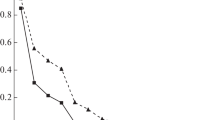Abstract—We identified the main genetic characteristics of the Kamchatka–Chukotka gyrfalcon (Falco rusticolus) population using nine nuclear microsatellite loci. Eight loci are polymorphic, with two to 15 alleles per locus. The average number of alleles per locus is 4.44. The values of expected and observed heterozygosity lie within 0.081–0.888 and 0.085–0.781, respectively. These levels of heterozygosity are comparable. The fixation index value (0.018 ± 0.037) indicates a genotypic equilibrium and makes it possible to suggest that the study population at its current size is genetically sufficient and that there is no inbreeding. Our data have been compared with world populations. As a result, we can state that the studied population, along with the Alaskan population, comprises most of the genetic diversity of the species. The selected and tested nuclear microsatellite loci (NVH fr34, NVH fp13, NVH fp46-1, NVH fp54, NVH fp79-4, NVH fp82-2, NVH fp89, and NVH fp92-1) have been determined as suitable for both individual identification and certification of birds in captivity, as well as for programs of genetic monitoring of wild populations.
Similar content being viewed by others
REFERENCES
Bradley, B.J., Doran-Sheehy, D.M., and Vigilant, L., Genetic identification of elusive animals: re-evaluating tracking and nesting data for wild western gorillas, J. Zool., 2008, vol. 275, no. 4, pp. 333–340.
Brookfield, J.F.Y., A simple new method for estimating null allele frequency from heterozygote deficiency, Mol. Ecol., 1996, vol. 5, no. 3, pp. 453–455.
Dawnay, N., Ogden, R., Wetton, J.H., Thorpe, R.S., and McEwing, R., Genetic data from 28 STR loci for forensic individual identification and parentage analyses in 6 bird of prey species, Forensic Sci. Int.: Genet., 2009, vol. 3, no. 2, рр. е63–е69.
Dement’ev, G.P., Sokola-krechety (Merlins-Falcons), Moscow: Moskovskoe obshchestvo ispytatelei prirody, 1951.
Dement’ev, G.N., Gladkov, N.A., Ptushenko, E.S., Spangenberg, E.P., and Sudilovskaya, L.M., Ptitsy Sovetskogo Soyuza (Birds of the Soviet Union), Dement’ev, G.P. and Gladkov, N.A., Eds., Moscow: Sovetskaya Nauka, 1951, vol. 1.
Johnson, J.A., Burnham, K.K., Burnham, W.A., and Mindell, D.P., Genetic structure among continental and island populations of gyrfalcons, Mol. Ecol., 2007, vol. 16, no. 15, pp. 3145–3160.
Mudrik, E.A., Kashentseva, T.A., Gamburg, E.A., and Politov, D.V., Genetic passportization and identification of Siberian cranes (Grus leucogeranus Pallas) in captivity, Biol. Bull. (Moscow), 2014, vol. 41, no. 3, pp. 208–215.
Nesje, M. and Røed, K.H., Microsatellite DNA markers from the gyrfalcon (Falco rusticolus) and their use in other raptor species, Mol. Ecol., 2000, vol. 9, no. 9, pp. 1438–1440.
Nesje, M., Røed, K.H., Lifjeld, J.T., Lindberg, P., and Steen, O.F., Genetic relationships in the peregrine falcon (Falco peregrinus) analysed by microsatellite DNA markers, Mol. Ecol., 2000, vol. 9, no. 1, pp. 53–60.
Nittinger, F., Haring, E., Pinsker, W., Wink, M., and Gamauf, A., Out of Africa? Phylogenetic relationships between Falco biarmicus and the other hierofalcons (Aves: Falconidae), J. Zool. Syst. Evol. Res., 2005, vol. 43, no. 4, pp. 321–331.
Van Oosterhout, C., Hutchinson, W.F., Wills, D.P.M., and Shipley, P., Micro-checker: software for identifying and correcting genotyping errors in microsatellite data, Mol. Ecol. Notes, 2004, vol. 4, no. 3, pp. 535–538.
Ostapenko, V.A., Sorokin, A.G., and Beme, I.R., On the necessity of conservation of the gyrfalcon (Falco rusticolus), in Khishchnye ptitsy i sovy v zooparkakh i pitomnikakh: ezhegodnik (Birds of Prey and Owls in Zoos and Breeding Facilities: A Yearbook), Moscow: GBU, 2012, no. 21, рр. 12–19.
Peakall, R. and Smouse, P.E., GenAlEx 6: genetic analysis in Excel. Population genetic software for teaching and research, Mol. Ecol. Notes, 2006, vol. 6, no. 1, pp. 288–295.
Peakall, R. and Smouse, P.E., GenAlEx 6.5: genetic analysis in Excel. Population genetic software for teaching and research—an update, Bioinformatics, 2012, vol. 28, no. 19, pp. 2537–2539.
Rudnick, J.A., Katzner, T.E., Bragin, E.A., Rhodes, O.E., Jr., and Dewoody, J.A., Using naturally shed feathers for individual identification, genetic parentage analyses, and population monitoring in an endangered eastern imperial eagle (Aquila heliaca) population from Kazakhstan, Mol. Ecol., 2005, vol. 14, no. 10, pp. 2959–2967.
Schwartz, M.K., Luikart, G., and Waples, R.S., Genetic monitoring as a promising tool for conservation and management, Trends Ecol. Evol., 2006, vol. 22, no. 1, pp. 25–33.
Selkoe, K.A. and Toonen, R.J., Microsatellites for ecologists: a practical guide to using and evaluating microsatellite markers, Ecol. Lett., 2006, vol. 9, no. 5, pp. 615–629.
ACKNOWLEDGMENTS
We are grateful to the deputy director of the Federal Service for Supervision of Natural Resource Use of Russia, V.V. Smolin; the director of the Federal Service for Supervision of Natural Resource Use in Chukotka Autonomous Okrug, N.P. Maksimova; the inspector of the Federal Service for Supervision of Natural Resource Use in Chukotka Autonomous Okrug, S.V. Levashov; and an employee of Vitasphera Breeding Center, A.B. Sarycheva, for help and assistance in material collection.
This work was supported in part by the Russian Science Foundation (project no. 14-50-00029) and the Russian Foundation for Basic Research (project no. 15-29-02771 ofi_m).
Author information
Authors and Affiliations
Corresponding author
Ethics declarations
Conflict of interests. The authors declare that they have no conflict of interest.
Statement on the welfare of animals. All applicable international, national, and/or institutional guidelines for the care and use of animals were followed.
Additional information
Translated by A. Lisenkova
Rights and permissions
About this article
Cite this article
Nechaeva, A.V., Belokon, M.M., Belokon, Y.S. et al. Genetic Diversity of the Chukotka–Kamchatka Gyrfalcon (Falco rusticolus, Falconiformes, Falconidae) Population, Based on an Analysis of Nuclear Microsatellite Loci. Biol Bull Russ Acad Sci 45, 956–960 (2018). https://doi.org/10.1134/S1062359018090121
Received:
Published:
Issue Date:
DOI: https://doi.org/10.1134/S1062359018090121



